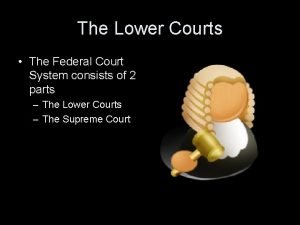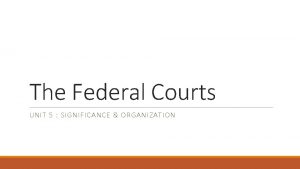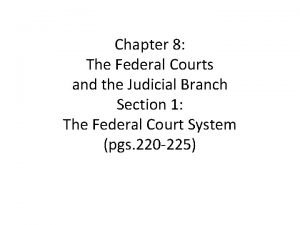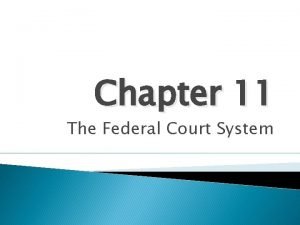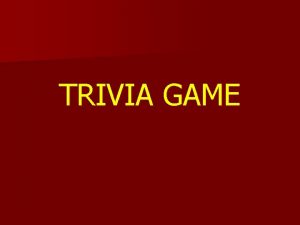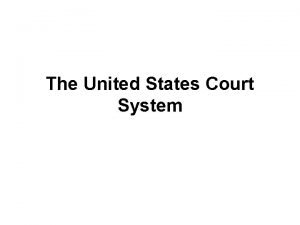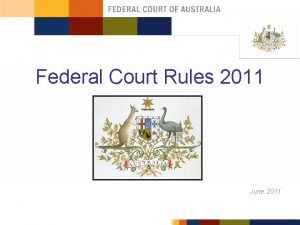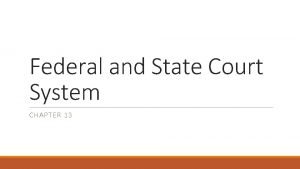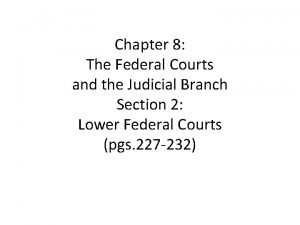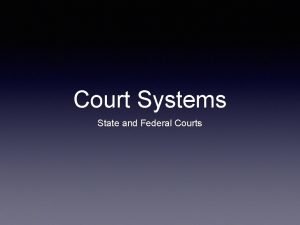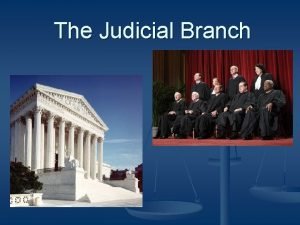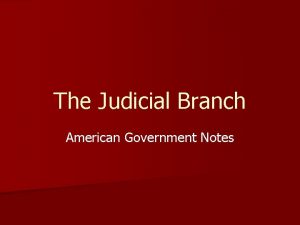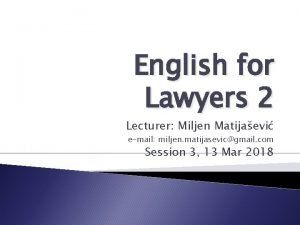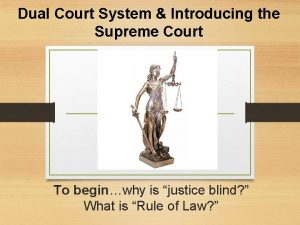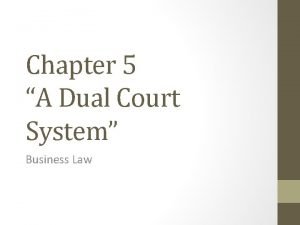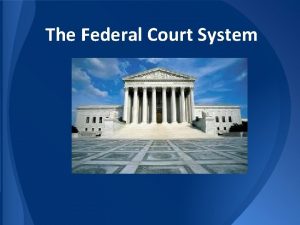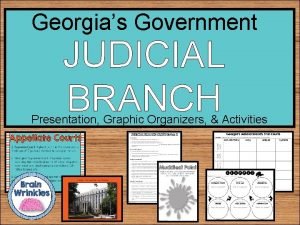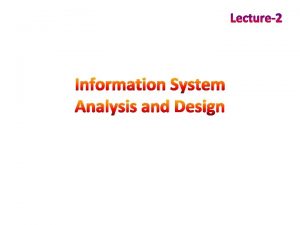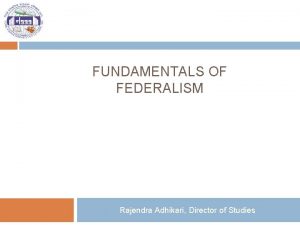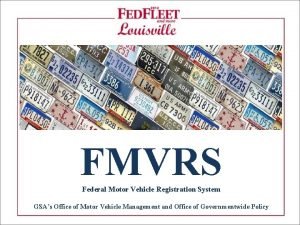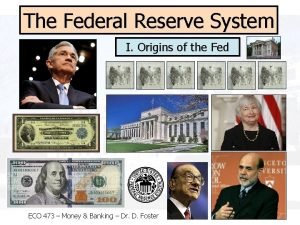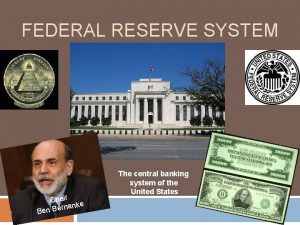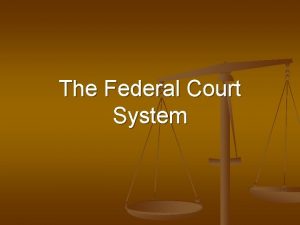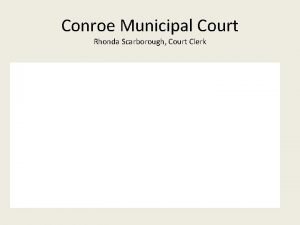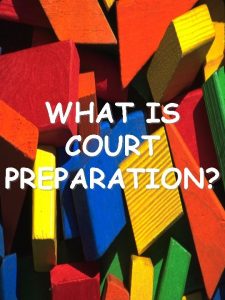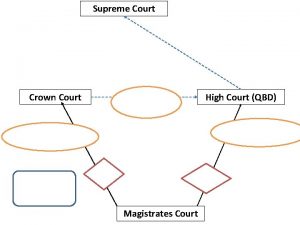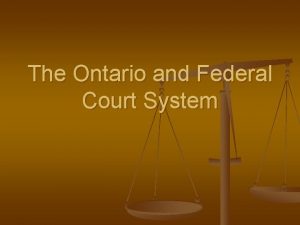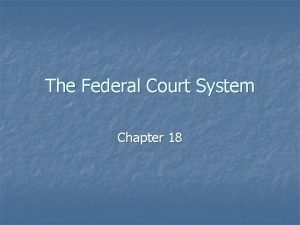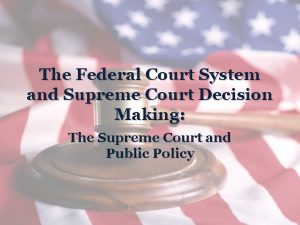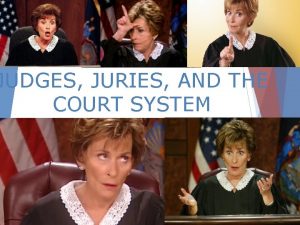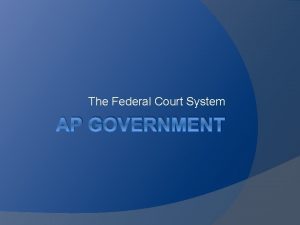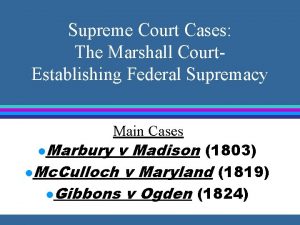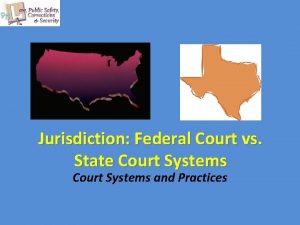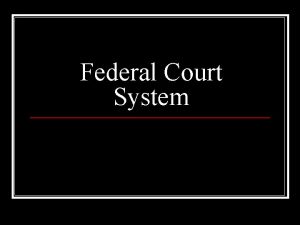The Federal Court System Characteristics of the Federal

























- Slides: 25

The Federal Court System

Characteristics of the Federal Court System Adversarial Provides and arena for two parties to bring their conflicts before in impartial judges Plaintiff brings a charge Defendant if being charged Passive • Federal judges are restrained by the Constitution to deciding actual disputes rather than hypothetical ones • The judiciary is a passive branch of government that depends on others to take the initiative

Jurisdiction The courts authority to hear a case Types Original- Courts in which a case is first heard Appellate- Courts that hear cases brought to them on appeal from a lower court Exclusive- cases that can only be heard in certain courts Concurrent- cases that ca be hear in either federal or state court Dual Court System Ø Due to federalism the US has two separate court systems Ø Each of the 50 states has its own system of courts. 90% of all criminal cases are heard in state and local courts Ø The federal judiciary spans the entire country

The Federal Court System The Constitution The Supreme Court is the only court mentioned in the Constitution The Constitution gives Congress power to create all other federal courts

The Judiciary Act of 1789 Established the basic three tiered structure of the federal courts that still exist Set the size of the Supreme Court at 6 justices, this was expanded to 9 in 1869

District Courts There are 94 district court staffed by just under 700 judges. Every state has a least one district court. They handle over 300, 000 cases a year or about 80% of the federal caseload Most cases end in plea bargain negotiated by the defense and prosecution. Only about 2% of the cases are decided by trials

Court of Appeals Courts authorized to review all district court decisions They are empowered to rule on decisions of federal regulatory agencies such as FTC. Do not hold trials or hear testimony

The Supreme Court “court of last resort”—Reviews cases from the United States courts of appeals and state supreme courts Final arbiter of the Constitution, decisions establish precedents that are binding to the entire nation Marbury v Madison Established the power of judicial review The power of the Supreme Court to declare federal legislation invalid if the legislation violates the Constitution

Selection of Judges The Lower Courts Federal judges appointed by President confirmed by Senate Senatorial Courtesy is practiced. The Supreme Court Nominated by President Criteria Competence: Impressive credentials, including judicial or governmental experience Ideology and policy preference: Share presidents policy preferences. Race, ethnicity and gender: Presidents pay close attention to race, ethnicity and gender. The Supreme Court has had two African American, 3 female and one Hispanic justice.

Confirmation Name of possible nominees are set to FBI for background check. Names are also sent to ABA for a professional rating Interest groups are playing more and more of a role in the confirmation process. Interest group tactics include protest, appearances on TV and radio talk shows, media usage, editorials and emails to senators. The Senate judiciary committee holds public hearing on each Supreme Court nominee. The committee then makes a recommendation to the full Senate.

How the Supreme Court Works Selecting Cases The Supreme Court has original jurisdiction in cases involving Two or more States The United States and a State Government The United States and foreign ambassadors and diplomats

Writs of Certiorari The court original jurisdiction only generates two to three cases a year. The remainder come from appeals Nearly all appealed cases reach the Supreme Court. A writ of certiorari is an order by the Court directing a lower court to send up the record in a given case for its review The certiorari process enables the Supreme Court to control its own caseload. Cases must involve serious constitutional issues or the interpretation of a federal statue, action or treaty.

Rule of Four Supreme Court clerks screen the 9, 000 petitions that come to the Court each term These clerks are exceptional law school graduated who have experience clerking for a judge or the court of appeals Weekly meetings are held with the justices where they discuss petition prepared by the clerks For a case to be heard 4 of 9 justices must agree to hear. This is called Rule of Four

Solicitor General Is the fourth ranking member of the DOJ He is responsible for handling all appeals on behalf of the Supreme Court He plays an important role in influencing the Courts decision on which cases to hear

Filing Briefs Each party is required to file a brief (detailed written statement) arguing on side of the case. Interest persons and groups that are not actual parties the case may file amicus curiae (Friend of the court) briefs. Cases involving controversial issues such as affirmative action attract a large number of amicus curiae briefs. Interest groups use these briefs to lobby the Court.

Oral Arguments Oral arguments are open to the public Attorneys are allowed 30 minutes to present their case

Discussion and Voting The justices discuss each case in a closed meeting held on Friday The Chief Justice presides over the meeting. Chief Justice Roberts is know to encourage discussion

Writing Opinions After reaching a decision, the justices must write a formal opinion. Opinions present issues, establish precedents and set guidelines for the lower court Majority opinion: Officially know as “the opinion of the Court”, the majority opinion is the law of the land Concurring opinion: Supports the majority opinion but stresses different constitutional or legal reasons for the judgment. Minority or dissenting opinion: Expresses a point of view that disagrees with the majority opinion. Dissenting opinions have no legal standing

Factors that Influence Supreme Court Decisions Precedent: Stare Decisis: Latin Phrase meaning “Let the decision stand” The vast majority of Supreme Court decisions are based on precedents established in earlier cases Precedents help make Supreme Court Decision more uniform, predictable and efficient

Examples Marbury v Madison established the principle of judicial review as applied to Congress and the president. In Martin v. Hunter’s lessee, the Court extended the power of judicial review to overrule state courts In Baker v. Carr the Supreme Court established the principle of one person, one vote. In Wesbury v. Sanders, the Court applied this principle to congressional districts.

Exceptions: Although precedent is very important, the Court can overturn previous decisions Plessy v. Ferguson permitted segregation if the facilities were “separate but equal”. The Court reversed this ruling in Brown v. Board of Education of Topeka, declaring that “segregation is a denial of the equal protection of the laws”, as outlined in the 14 th amendment. Incorporation Doctrine.

Judicial Philosophy Judicial Restraint: Advocated of judicial restraint argue that the Supreme Court should use precedent and the Framers original intent to decide cases Advocated of judicial restraint also argue that the Supreme Court should defer to the elected institutions of government

Judicial Activism Advocates of Judicial Activism argue that the federal courts must correct injustices when other branches do not Brown v. Board of Education is an example of how judicial activism promoted social justice

Public Opinion Supreme Court is insulate from direct political pressure Justices are appointed for life subject to good behavior Salaries cannot be reduced Certiorari process enables the Court to set its own agenda The public has limited access to Court proceedings

Supreme Court is aware and sensitive to public opinion Appointment and confirmation processes keep the Supreme Court from deviating too far from public opinion Congress and State legislators can amend the Constitution Congress can change the Supreme Court appellate jurisdiction Congress has the power to change the number of justices on the court Justices can be impeached
 Federal court system structure
Federal court system structure Federal court system structure
Federal court system structure Dual court system answer key pdf
Dual court system answer key pdf The federal court system chapter 11 answer key
The federal court system chapter 11 answer key Structure of the court system
Structure of the court system Is there a basketball court above the supreme court
Is there a basketball court above the supreme court Us circuit court map
Us circuit court map Federal court rules 2011
Federal court rules 2011 Lower court
Lower court Federal district court map new york
Federal district court map new york Federal court structure
Federal court structure Federal and state court systems
Federal and state court systems Us court system chart
Us court system chart The dual court system in the u.s. means
The dual court system in the u.s. means France absolute location
France absolute location England court system
England court system Morse v frederick summary
Morse v frederick summary Dual court system answer key pdf
Dual court system answer key pdf Supreme court justice system
Supreme court justice system Georgia court system
Georgia court system Characteristics of system analysis
Characteristics of system analysis यगत
यगत Gsa fmvrs
Gsa fmvrs Federal reserve system
Federal reserve system Fractional banking system
Fractional banking system Federal reserve system
Federal reserve system
